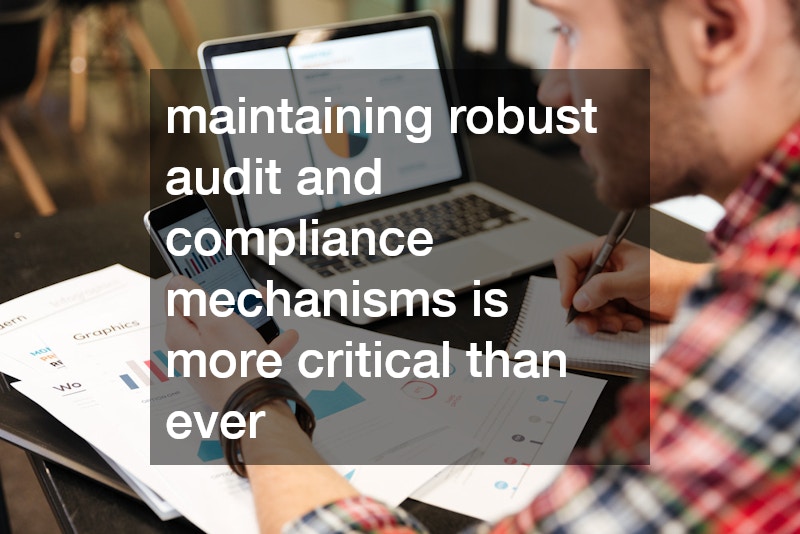In today’s rapidly evolving business landscape, maintaining robust audit and compliance mechanisms is more critical than ever. Organizations are under constant scrutiny from regulators, stakeholders, and customers to uphold high standards of governance, risk management, and compliance. Implementing effective audit and compliance solutions can significantly streamline these processes, ensuring that businesses operate within the legal frameworks and industry standards. However, the path to successful implementation is fraught with challenges.
This article explores best practices for implementing audit and compliance solutions and highlights common pitfalls to avoid.
Understanding Audit and Compliance Solutions
Audit and compliance solutions are integrated systems designed to help businesses manage and monitor their compliance with regulatory requirements, internal policies, and industry standards. These solutions provide tools for tracking, documenting, and reporting compliance activities, as well as for conducting internal audits. By automating and centralizing these functions, organizations can enhance transparency, reduce risks, and ensure accountability.
Best Practices for Implementing Audit and Compliance Solutions
Assess Organizational Needs and Objectives
Before selecting and implementing an audit and compliance solution, it’s crucial to understand the specific needs and objectives of your organization. Conduct a thorough assessment of your current compliance landscape, identify gaps and vulnerabilities, and define your goals. This step ensures that the chosen solution aligns with your organizational priorities and provides the necessary features and functionalities.
Choose the Right Solution
Selecting the appropriate audit and compliance solution is a critical decision. Evaluate different solutions based on their capabilities, scalability, ease of use, and integration potential with existing systems. Consider factors such as the size of your organization, industry-specific requirements, and budget constraints. Opt for a solution that not only meets your current needs but can also adapt to future regulatory changes and business growth.
Engage Stakeholders
Successful implementation of audit and compliance solutions requires the involvement and buy-in of key stakeholders across the organization. Engage senior management, compliance officers, IT teams, and end-users early in the process. Their input and support are vital for overcoming resistance to change, ensuring adequate resource allocation, and fostering a culture of compliance.
Develop a Comprehensive Implementation Plan
A well-structured implementation plan is essential for guiding the deployment of the audit and compliance solution. This plan should outline the project timeline, key milestones, responsibilities, and resource requirements. Include provisions for data migration, system integration, user training, and testing. A phased approach can be beneficial, allowing for incremental improvements and adjustments based on feedback and performance metrics.
Invest in Training and Support
The effectiveness of any audit and compliance solution depends on the proficiency of its users. Invest in comprehensive training programs to ensure that all relevant personnel understand how to use the system effectively. Provide ongoing support through help desks, user manuals, and refresher courses. Training should cover not only technical aspects but also the importance of compliance and the role of the solution in achieving organizational goals.
Monitor and Evaluate Performance
Continuous monitoring and evaluation are crucial for the long-term success of audit and compliance solutions. Establish key performance indicators (KPIs) to measure the effectiveness of the system and its impact on compliance activities. Regularly review audit logs, compliance reports, and user feedback to identify areas for improvement. This proactive approach helps in fine-tuning the solution and addressing emerging risks and challenges.
Common Pitfalls to Avoid
Lack of Clear Objectives
Implementing audit and compliance solutions without clear objectives can lead to confusion, misalignment, and wasted resources. Ensure that you have well-defined goals and a clear understanding of what you aim to achieve with the solution.
Ignoring Stakeholder Input
Failing to involve key stakeholders can result in resistance to change and poor adoption rates. Engage all relevant parties from the outset to gain their insights, address concerns, and foster a collaborative environment.
Overlooking Integration Needs
Audit and compliance solutions should seamlessly integrate with existing systems and processes. Overlooking integration requirements can lead to data silos, inefficiencies, and incomplete compliance monitoring. Conduct thorough compatibility checks and plan for necessary integrations.
Inadequate Training and Support
Insufficient training and support can hinder the effective use of audit and compliance solutions. Ensure that users are well-trained and have access to ongoing support to maximize the system’s potential and avoid misuse or neglect.
Neglecting Continuous Improvement
Compliance landscapes are dynamic, with regulations and standards evolving regularly. Neglecting continuous improvement efforts can render your audit and compliance solutions outdated and ineffective. Stay abreast of regulatory changes and update your systems and processes accordingly.
Conclusion
Implementing audit and compliance solutions is a strategic investment that can enhance an organization’s ability to manage risks, ensure regulatory adherence, and promote operational excellence. By following best practices such as assessing organizational needs, choosing the right solution, engaging stakeholders, developing a comprehensive implementation plan, investing in training and support, and continuously monitoring performance, businesses can successfully navigate the complexities of compliance management. Avoiding common pitfalls like unclear objectives, ignoring stakeholder input, overlooking integration needs, inadequate training, and neglecting continuous improvement will further ensure the effective deployment and utilization of these solutions.
With the right approach, audit and compliance solutions can transform how organizations handle their regulatory responsibilities, paving the way for sustainable growth and success.
.


